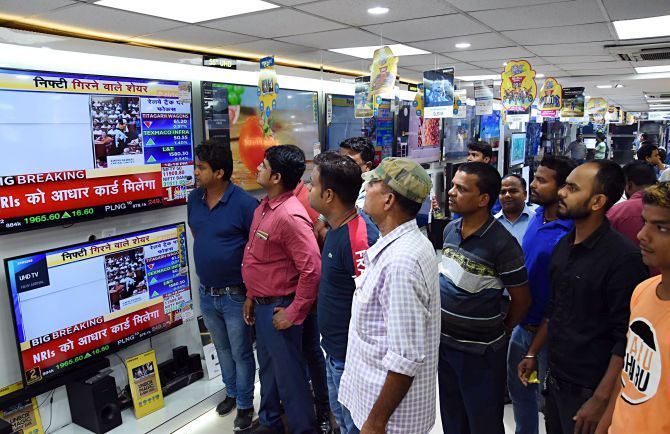 | « Back to article | Print this article |
Nearly all FMCG companies like Marico, HUL, ITC and the rest have been indicating that the operating environment has been challenging, with drop in consumption, especially in rural areas, severe crunch in market liquidity conditions, and disruptions and floods in several parts of the country. To overcome this, they are boosting their direct reach in the countryside.

Fast-moving consumer goods (FMCG) majors like ITC and Emami are scaling up their direct reach in rural areas to combat subdued consumer sentiment in these pockets.
They hope such a move -- backed by consumer connect initiatives -- can help push sales.
In view of the ongoing slowdown, which has impacted demand in rural India, ITC doubled its rural stockist network in the current financial year, with significant increase in coverage across low population group markets.
“We have actively increased our direct reach in rural India by adding more than 25 per cent new markets to the existing large serviced base,” said an ITC spokesperson.
ITC’s handler base currently stands at 6.2 million outlets and it continued to deploy resources to augment the outlet coverage aggressively, with nearly 80 per cent of new handlers added in the current year coming from a rural base.
In case of Emami, which has one of the highest exposures in rural areas among its peers, the company is banking on its Project Dhanush initiative, which it undertook three years ago.
In the past three years under this initiative, aimed at reaching the deepest and remotest of geographies, Emami expanded its footprint to more than 20,000 towns with a population of around 3,000.
“Van branding and visual merchandising at outlets through point-of-purchase visibility has proved to be an effective consumer influencer fuelling rural channel growth,” said Mohan Goenka, director at Emami.
With more than 3,000 distributors and 600,000-plus square feet of trade assets, which incidentally is the largest in store merchandising in the country, Hindustan Unilever (HUL) also has prioritised increasing its direct distribution reach.
According to an open access journal, International Journal of Research, Granthaalayah, over the decades since its launch in 1997, HUL has appointed 6,000 sub-stockists, because of which its distribution network directly covered about 50,000 villages and is reaching 250 million consumers.
This translates into reaching 37 per cent of rural consumers directly.
The rural distributor has a set of stockists attached to it that drives distribution in villages using unconventional transport like tractors, bullock carts and others.
Nearly all FMCG companies like Marico, HUL, ITC and the rest have been indicating that the operating environment has been challenging, with drop in consumption, especially in rural areas, severe crunch in market liquidity conditions, and disruptions and floods in several parts of the country.
While ITC continued its rural consumer connect programmes in identified low population group markets with its brand communication focused on highlighting consumer value offers and build social and emotive brand connect, Emami strengthened its brand connect by associating popular brand endorsers who enjoy mass reach equally cutting across both urban and rural markets.
On the other hand, FMCG players are also leveraging e-commerce platforms and using digital technology to drive sales.
For example, both HUL as well as ITC is using Big Data analytics to attract consumers from small towns or rural India by offering suitable products, stock-keeping units, and communicating its portfolio. HUL has also come up with an online ordering app for its salespeople as well as opt for customised promotions.
“FMCG brands are leveraging e-commerce platforms to offer their products catering to the growing demand. In 2020, we got orders from big cities as well as smaller ones such as Ajmer, Bharuch, Chittoor, Dharwad, among others. We are consistently widening our selection of FMCG daily essentials by making them available to customers throughout the country with our growing infrastructure capabilities,” an Amazon spokesperson told this business daily.
According to Nielsen India, FMCG sales via the e-commerce route are expected to grow to $4 billion by 2022.